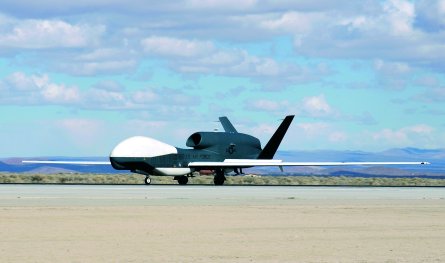The US Navy is planning outlays of up to $2.31 billion for its proposed endurance unmanned air vehicle-based broad area maritime surveillance system under revised budget forecasts released to bidders 8 February.
The planned outlays represent a $1.3 billion boost to programme funding and come ahead of an expected release of a request for proposals later this month ahead of a source selection decision in September.
The Navy is also interested in early achievement of an initial operational capability for the system. Current plans are based on a target of 2014. However the service has used a bidders briefing held in Lexington, Maryland on 9 February to advise it wants proposals on faster delivery options.
BAMS programme office integrated project team leader Cdr Bob Dishman told the briefing that “there is an objective for an initial operational capability in 2013 or earlier but again we want to see a realistic schedule that is executable in the [industry] proposal[s]”.

Northrop Grumman's RQ-4B Global Hawk is a key contender for the BAMS requirement
The draft programme budget now about to go before Congress for approvals proposes outlays of $116.7 million during the US 2008 financial year, rising to $480.3 million in FY09, and peaking at $560.9 million in FY2010. Outlays for 2011 are forecast at $466.2 million, decreasing to $386.6 million in 2012 and $281.6 million in 2013.
Dishman said that funding estimates for 2014 are still being determined and are dependent on programme scheduling and progress.
The BAMS request for proposal is expected to close in mid April, 60 days after release, with a milestone B source selection from September. Contract award for the system development and demonstration phase is planned for early 2008.
BAMS is predicated on the establishment of five orbits deployed around the globe, with each providing a target of 43,800 flight hours a year with no more than three UAVs airborne in each orbit at any given time. Programme officials said the project is interested in proposals for achieving those flight hour targets using just two UAVs airborne in each orbit.
The updated tender specification now includes requirements for the BAMS system to be able to provide effective time on station targets (ETOS) of 95% over a 30 day period says the Naval Air Systems Command’s unmanned air system programme office (PMA 263). PMA 263 chief engineer Tom Garrett told the briefing that “the threshold requirements and what you see in ETOS calculations is 80% ETOS at 2000nm for seven days. That is a threshold requirement. Objective requirements associated with that are 95% ETOS at 2,000nm for 30 days or 80% at 3,000nm. There are several different ways of looking at it and they have all been added to the objectives at the beginning of the specification.”
Objective time on station requirements at 2,000nm have been set at 10h.
The specification also now includes requirements for the air vehicle to be able to handle moderate icing and turbulence conditions. The UAV is also now expected to be capable of unaided autonomous landings at pre-surveyed airfields.
New air traffic integration requirements include the addition of an IFF interrogation capability aboard the UAV, and an ability for the main and forward operating bases to be able to manually inhibit IFF transmissions during operations.
BAMS ground control environment requirements have also been changed to include an ability to handle three UAV’s simultaneously.
Programme officials also confirmed they are looking to be able to carry out in flight command and control of the BAMS aircraft from operators aboard the Navy’s planned EPX signals intelligence gathering aircraft, as well as receive data aboard the new Boeing P-8A Multimission Maritime Aircraft (MMA).
This is in addition to existing requirements to be able to stream data direct from the UAV to the P-8A MMA for processing as part of cooperative operations.
Office of the Chief of Naval Operations BAMS sponsor LtCdr Tim Day told the briefing that “it is very important that we be interoperable with the manned aircraft that will also be on station. We want MMA to be able to receive sensor data directly so that it can benefit from the BAMS presence. In addition, as the EPX requirements develop, they intend to incorporate control of the unmanned aircraft from that aircraft.
“BAMS will provide the battlespace awareness when the MMA is operating down low or operating in another location or doing another mission. BAMS will be interoperable with it; it can extend the sensor range in co-operative targeting with the EPX and the P-8A as well. There is a very tight relationship there that is very important to understand.”
The EPX platform could also operate as a network node for the BAMS systems where satellite links or sufficient bandwidth is not available.
Source: FlightGlobal.com























